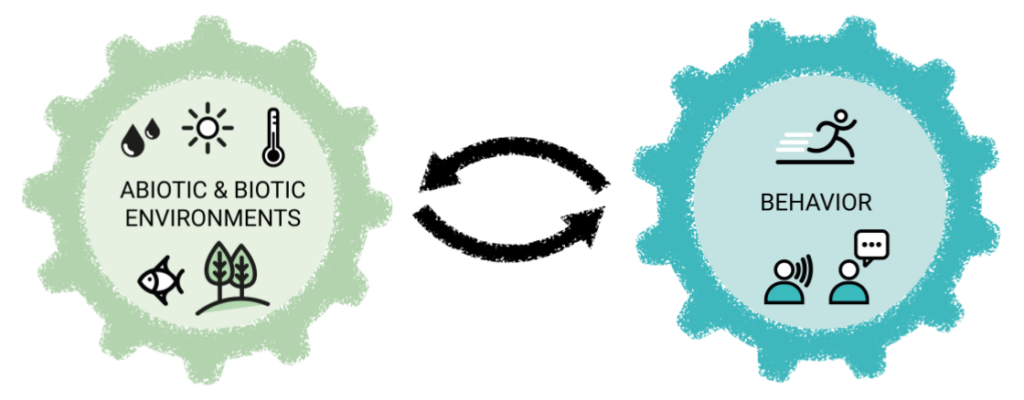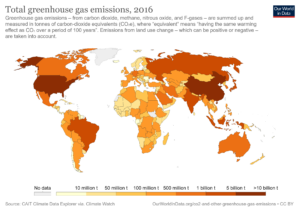Impacts on the Environment
All living things live in interaction with their environment. That is, their behavior changes the environment more or less, and environmental conditions in turn affect them, their behavior, their chances of survival and reproduction.

Interactions between the behavior of living organisms and their environment
All living things are also adapted to certain environmental conditions. Some species are “specialists” and can exist only under very narrow environmental conditions. Other species are “generalists” and can exist in variable conditions. Humans are generalists because, through our capacity for cultural evolution, we inhabit almost all areas of the earth. Nevertheless, our flexibility is not limitless. Changes in environmental conditions in the future, such as climate and the increase in extreme weather phenomena, sea level rise, changes in ocean currents and land masses, desertification, erosion, drop in groundwater level, are challenges to the sustainable development of our species and of many other species.
Many living things “create” part of their environment through their own behavior. Examples are earthworms, which loosen up the earth by their movements, and thus provide for oxygen supply; animals that create nests, holes, nets, and burrows; beavers who build their dams and thus create whole ecosystems, on which the beavers and their offspring depend in turn for their survival. When living organisms are adapted to specific environmental conditions, and their behavior changes these environmental conditions, they may have lower chances of survival and reproduction than those who maintain favorable environmental conditions. Thus, through natural selection, interactions between organisms and the environment can arise in the course of evolution, which can last for millions of years.
We humans also change and create our own environment. Thanks to better and better technologies, we have had more and more effective ways of changing our environment and improving our living conditions – we used fire, cleared trees, built dwellings, hunted large animals, made clothes, planted plants, built dams, etc. Through cumulative culture and processes of cultural evolution, our technologies have been improved to such an extent that our behaviors and technologies have changed our own environment in more and more drastic ways. When certain resources were no longer sufficiently available, people moved on, opening up new areas or new resources.
In particular, food production through agriculture fundamentally changed our environment. The rapid growth of our population has also meant that the behavior of more and more people has had an impact on the shared environment. In addition, today we can hardly explore new areas – with many resources we have arrived at the limit of the earth’s carrying capacity. All this happened – from an evolutionary point of view – in a relatively short period of time.
Because of our evolutionary history, we are capable of sharing and maintaining our shared resources within small groups. But for us it is a challenge to monitor the impact of our actions in ever larger groups, and to regulate our behavior together in large groups. The development of regulations and institutions that can govern coexistence and resource use at regional and international levels is therefore an important element for the sustainable use of global resources and protection of ecosystems.
Goal 2 of Global Sustainable Development Goals is to end hunger in the world.
Goal 12 of Global Sustainable Development Goals is to make our resource consumption and production more sustainable.
Goal 14 of the Global Sustainable Development Goals is to sustainably use and conserve oceans, seas and marine resources.
Goal 15 of Global Sustainable Development Goals is to protect and restore land and water ecosystems, promote their sustainable use, sustainably manage forests, combat desertification, end and reverse soil degradation, and end biodiversity loss.
How can we ensure that all people have access to quality food and other important resources and at the same time, that our diets and consumption behaviors have no negative impact on terrestrial and aquatic ecosystems?
What role can and should our technologies, commonly-established regulations, social norms, our own behavior, media and education play?
Land use for agriculture
Agricultural food production has fundamentally changed the impact of our diet on the environment. Forests and other ecosystems had to give way to crop land and pastures, and food production on these areas changed the soil, water balance, local flora and fauna.
Technologies for food production increased the consumption of energy and water. This way agriculture contributes significantly to climate change.
In addition, continued population growth requires an increase in food production of around 70% by 2050. Today, around 800 million people are suffering from hunger or malnutrition. At the same time, about a third of the food produced worldwide is thrown away.
Some people think that we should continue to invest in technologies that allow us to “extract” more quality food from one area of land, so we do not need to increase the amount of land for food production. Similarly, improved technologies and variety breeding could ensure that food stays fresh longer and less of the produced food is thrown away.
Other people say we should stop investing in energy-intensive technologies for agriculture as these can have an uncertain impact on ecosystems. According to them, we should rather return to less intensive agricultural methods, or exploit processes in existing ecosystems that can serve our food production. However, this might require an expansion of agricultural land to meet the food needs of a growing population, and thus could also have far-reaching ecosystem implications.
Other people also say that the best way to sustain global food security is by changing our diet, e.g. eat less meat, fish and dairy, or shifting to eating more insects. Similarly, we should change our behavior to throw away less food. However, behavioral change can be a challenge for individuals unless conditions are created that support these behavioral changes – e.g. through jointly established regulations and institutions.
Still others believe that through technology we can produce our food in the future without relying on crop land and livestock farming that intervene in ecosystems, e.g. through biotechnology, increased consumption of insects, and cell cultures. However, it is uncertain whether this type of food production would be more or less energy-intensive and would contribute more or less to climate change than “traditional” crop production and livestock farming.
Impacts on atmosphere and climate
A particular environmental impact comes from our use of fossil fuels. Within a century, use of fossil fuels has increased so much that the resulting emissions of CO2 and other greenhouse gases are changing the entire global climate. These effects affect people and ecosystems around the world more or less, and may have devastating effects on food production. This requires today that we find ways to work together on a global scale to limit climate change or to adapt to new climatic conditions.
Goal 13 of the Global Sustainable Development Goals is to take action to combat climate change and its impacts.
What conditions can hinder and favor our ability to collaborate around addressing global climate change?
How do inequalities, transparency, or climate science affect our ability to address climate change?
What role can and should our technologies, commonly-established regulations, social norms, our own behavior, media and education play?

Climate Change Game
A cooperation game that lets students experience some of the challenges of cooperation in addressing global climate change
This color-coded map displays a progression of changing global surface temperature anomalies from 1880 through 2018. Higher than normal temperatures are shown in red and lower than normal temperatures are shown in blue. The final frame represents the global temperatures 5-year averaged from 2014 through 2018. Scale in degree Celsius.
Biodiversity loss
Human resource use behaviors and technologies and our growing population have more and more dramatic impacts on ecosystems. Habitat loss and fragmentation through the conversion of land for agricultural purposes, direct use of species for food, construction, medicine, horticulture, tourist souvenirs, trade and other uses, pollution, changing climate and the introduction of invasive species are considered the main drivers of global biodiversity loss.
The IUCN (International Union for Conservation of Nature) Red List of Threatened Species is the world’s most comprehensive information source on the global conservation status of animal, fungi and plant species.
The IBAT (Integrated Biodiversity Assessment Tool) for Research and Conservation Planning is a tool to facilitate access to a range of data about protected areas, biological information about habitat and species diversity indices, and key areas for biodiversity, which can be useful for research and conservation planning purposes.
Lesson Ideas:
Students create a presentation or poster about a particular endangered species, group of species or region.
Under https://www.iucnredlist.org/search, students can search by species, region, Red List status, types of threats and conservation needs, and many other criteria, and download information documents about selected species. To save searches and other functions, you need to register a free account on the IUCN Red List website.
On the IBAT country profiles page https://conservation.ibat-alliance.org/nbsap/display, you can download reports per country on the number and types of species that are on the Red List, endemic species, types of threat, information about protected areas, key biodiversity areas and governance types. To access other functions such as map visualizations, you need to create a free account on https://www.ibat-alliance.org/subscriptions.
In a geography classroom, you may want students to focus on a particular region or country. In a biology classroom, you may want students to focus on particular types of species or ecosystems. In a social studies or economics classroom, you may want to focus on particular types of human use and trade of species, or focus on particular types of conservation measures and types of conservation governance systems.
What endangered species are there at a zoo or at a botanical garden near you? Choose one of the endangered species at your next zoo visit, find information about it on the IUCN or IBAT websites and make a poster about the species (include photos and other information that you gathered from your Zoo visit).
Impacts of technologies: Plastic
Another unforeseen environmental impact created by our technologies is the global production of plastic. The invention of plastic manufactured from mineral oil was a breakthrough for the industry, as this flexible, lightweight, unbreakable, inexpensive material made transportation of food and other things and industrial processing easier and cheaper. However, compared to other materials, plastic is nonbiodegradable. Thus, plastic accumulates more and more in the environment and endangers terrestrial and aquatic ecosystems. The largest share of plastic waste is currently being thrown away and only about 20% is recycled.
Goal 12 of Global Sustainability Goals is to make our consumption and production more sustainable.
What role can and should improving technologies, coordinated regulations, social norms, our own behavior, media and education play to reduce our plastic consumption and the impact of our plastic production on ecosystems?

